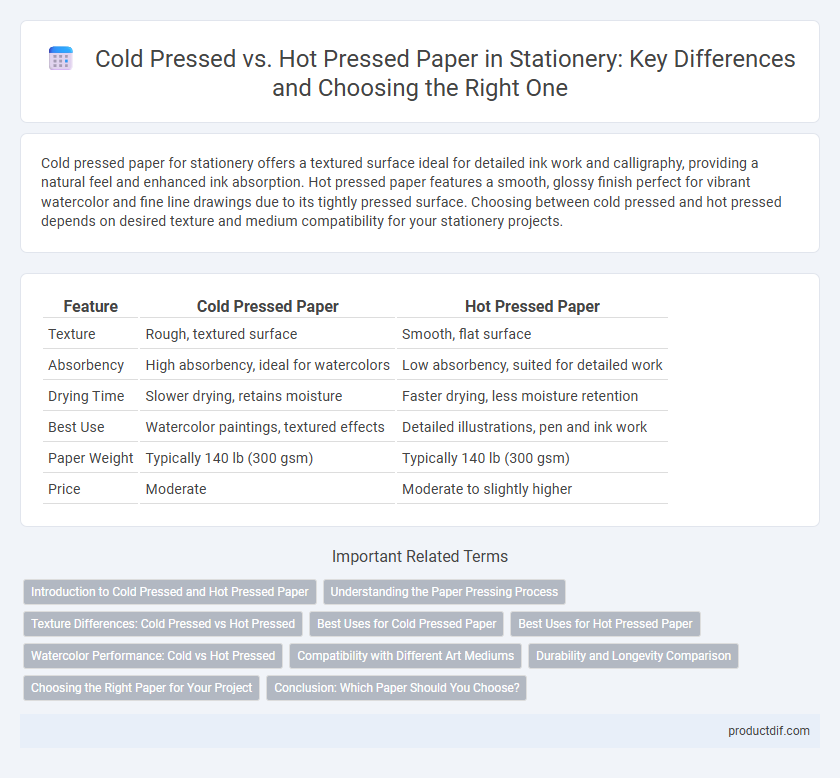Cold pressed paper for stationery offers a textured surface ideal for detailed ink work and calligraphy, providing a natural feel and enhanced ink absorption. Hot pressed paper features a smooth, glossy finish perfect for vibrant watercolor and fine line drawings due to its tightly pressed surface. Choosing between cold pressed and hot pressed depends on desired texture and medium compatibility for your stationery projects.
Table of Comparison
| Feature | Cold Pressed Paper | Hot Pressed Paper |
|---|---|---|
| Texture | Rough, textured surface | Smooth, flat surface |
| Absorbency | High absorbency, ideal for watercolors | Low absorbency, suited for detailed work |
| Drying Time | Slower drying, retains moisture | Faster drying, less moisture retention |
| Best Use | Watercolor paintings, textured effects | Detailed illustrations, pen and ink work |
| Paper Weight | Typically 140 lb (300 gsm) | Typically 140 lb (300 gsm) |
| Price | Moderate | Moderate to slightly higher |
Introduction to Cold Pressed and Hot Pressed Paper
Cold pressed paper features a textured surface with slight tooth, ideal for watercolor and mixed media artists seeking good paint absorption and controlled flow. Hot pressed paper is smooth and less absorbent, preferred for detailed work and precise line art due to its flat finish. Both papers originate from cotton or wood pulp fibers but differ in the pressing process that defines texture and application suitability.
Understanding the Paper Pressing Process
Cold pressed paper features a textured surface created by pressing the paper pulp between cold metal plates, enhancing absorbency and making it ideal for watercolor and mixed media. Hot pressed paper undergoes pressing by heated metal plates, resulting in a smooth, flat surface that suits detailed ink work and fine line drawings. Understanding the pressing process is crucial for selecting the right paper type, as it directly influences the paper's absorbency, texture, and suitability for different artistic techniques.
Texture Differences: Cold Pressed vs Hot Pressed
Cold pressed paper features a slightly textured, rough surface ideal for watercolor and mixed media, allowing better paint absorption and blending. Hot pressed paper has a smooth, flat texture preferred for fine detail work and pen illustrations due to minimal surface tooth. Choosing between cold pressed and hot pressed depends on desired texture effects and medium compatibility in artistic applications.
Best Uses for Cold Pressed Paper
Cold pressed paper, known for its slightly textured surface, is ideal for watercolor painting, providing excellent absorption and subtle color blending. Its medium texture offers control and versatility, making it suitable for artists who want to achieve detailed washes and varied brush strokes. This paper type excels in techniques requiring layering and lifting of paint without damaging the surface.
Best Uses for Hot Pressed Paper
Hot pressed paper features a smooth, non-textured surface that excels in detailed work such as fine line drawing, pen and ink illustration, and watercolor techniques requiring precision. Its even finish allows for crisp, clean application of color and ink, making it ideal for graphic design, botanical illustrations, and architectural sketches. Artists seeking vibrant color retention and sharp detail often prefer hot pressed paper for its ability to handle both wet and dry media without excessive absorption.
Watercolor Performance: Cold vs Hot Pressed
Cold pressed watercolor paper features a textured surface ideal for holding pigment and water, enhancing color vibrancy and blending. Hot pressed paper has a smooth, almost glossy finish, which allows for fine detail work but may cause pigments to sit on top, resulting in less absorbency. Artists often choose cold pressed for washes and blending, while hot pressed suits detailed illustrations and ink work.
Compatibility with Different Art Mediums
Cold pressed paper features a slightly textured surface ideal for watercolor, gouache, and acrylics, as it holds pigments well and allows for subtle blending effects. Hot pressed paper provides a smooth, non-absorbent surface preferred for detailed ink work, graphite, and marker illustrations due to its ability to showcase fine lines and sharp contrasts. Artists choose cold pressed for fluid washes and texture, while hot pressed supports precision and crisp detailing across various art mediums.
Durability and Longevity Comparison
Cold pressed paper exhibits greater durability and longevity due to its textured surface and higher density fibers, making it ideal for archival-quality artwork and documents. Hot pressed paper, while smoother and better suited for detailed illustrations, tends to be less robust over time and more susceptible to wear and tear. Cold pressed varieties resist yellowing and deterioration, ensuring prolonged preservation compared to hot pressed options.
Choosing the Right Paper for Your Project
Cold pressed paper features a slightly textured surface ideal for watercolor projects requiring controlled washes and detailed brushwork, enhancing pigment absorption for vibrant results. Hot pressed paper offers a smooth, flat finish perfect for intricate pen and ink illustrations or fine detail in mixed media artwork. Select cold pressed paper for expressive texture and layering, while hot pressed suits precision and smooth color application.
Conclusion: Which Paper Should You Choose?
Cold pressed paper offers a textured surface ideal for watercolor artists seeking rich pigment absorption and detailed blending, while hot pressed paper provides a smooth finish better suited for fine line work and detailed pen or ink illustrations. Choosing between cold pressed and hot pressed paper depends on your specific artistic needs, such as texture preference and medium compatibility. For versatile use, many artists prefer cold pressed paper for its balance of texture and absorbency, making it the most popular choice in stationery for watercolor and mixed media projects.
Cold Pressed vs Hot Pressed Infographic

 productdif.com
productdif.com